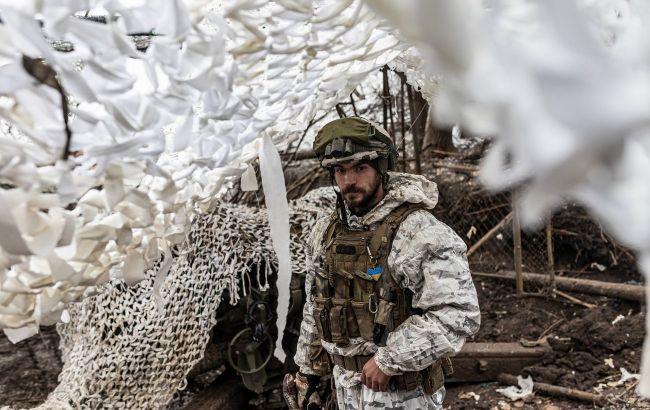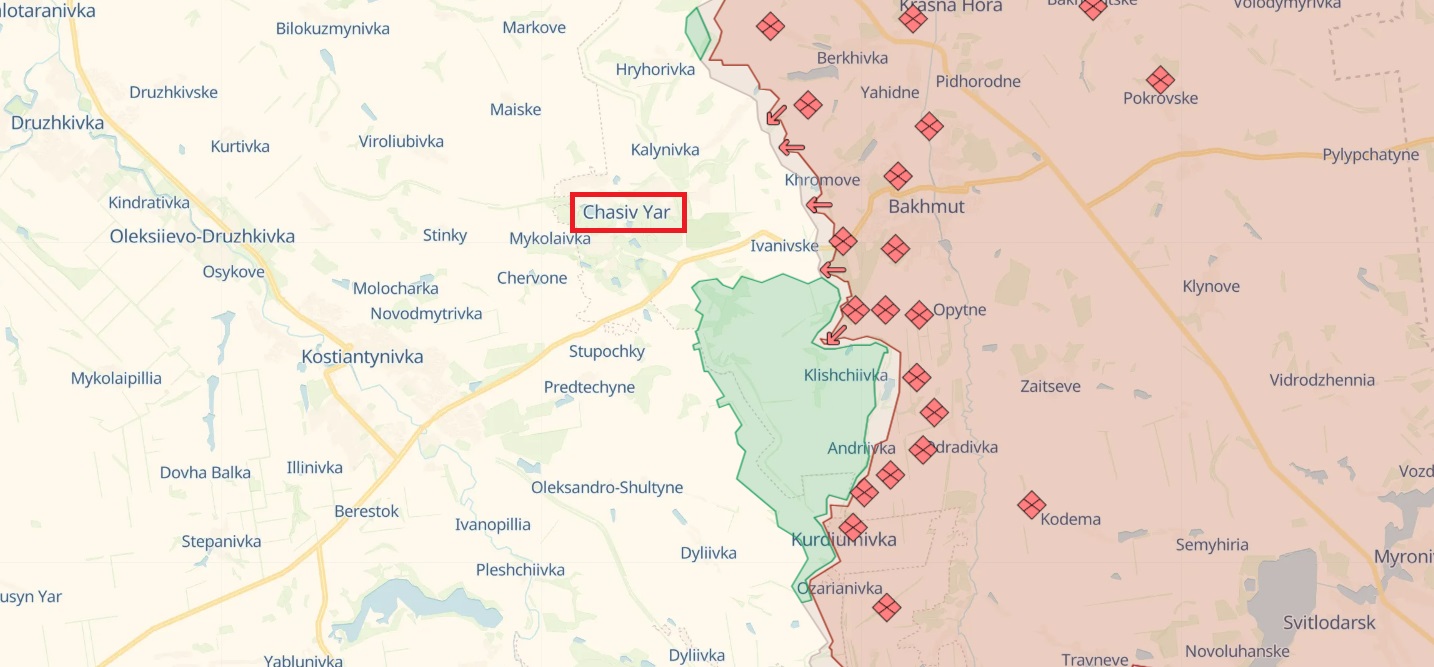Avdiivka, Kupiansk, and constant changes near Bakhmut: Frontline situation overview
 Ukrainian soldiers hold the line on the eastern front (photo by Getty Images)
Ukrainian soldiers hold the line on the eastern front (photo by Getty Images)
Russian troops are advancing in large numbers, with the hottest spots being Kupiansk, the Bakhmut area, Avdiivka, and Maryinka. Read about the situation at the front, the main threats, and how the enemy offensive in the east may develop in the RBC-Ukraine review.
The material was prepared based on the reports of the General Staff of the Armed Forces of Ukraine, statements of commanders and military speakers, analytics of the American Institute for the Study of War (ISW) and the Ukrainian project DeepState, British intelligence data, and comments of experts Oleksandr Kovalenko and Oleksii Hetman.
Kupiansk and the circular defense
About three dozen settlements within the Kharkiv region are occupied. And for several months now, Russian troops have been trying to expand their zone of control. The main target is the city of Kupiansk. To the northeast, the front has come close to Synkivka, the capture of which will threaten a further offensive on the district center.
"The situation is difficult. We have to fight in conditions of the enemy's superiority both in weapons and in the number of personnel," says the commander of the Land Forces, Oleksandr Syrskii.
The Russians are attacking the forest near Lyman Pershyi, have achieved partial success, and are trying to drive columns into Synkivka. So far, all attempts have been repelled. Volodymyr Fitio, spokesperson for the Land Forces, says that the assaults intensified in early October, and now the enemy is forced to pull up reserve battalions due to losses.
"They are actively using both equipment and human resources. Of course, they take more care of equipment, but human resources do not play a role for them. They send people to assaults, to reconnaissance by combat, and just to carry out meaty assaults," he adds.
 Russians attacking Kupiansk from the direction of Synkivka (photo by deepstatemap.live)
Russians attacking Kupiansk from the direction of Synkivka (photo by deepstatemap.live)
Beyond Kupiansk, the space opens up further to both Kharkiv and Izium, from where the enemy will again be able to threaten Sloviansk and Kramatorsk from the north. And apparently, the Ukrainian military is preparing for a serious battle for Kupiansk.
According to the head of the Kharkiv regional military administration, Oleg Synehubov, a ring defense of Kupiansk is being built, following the example of Kharkiv. Without going into details, Synehubov emphasizes that it will consist of several rings of defenses.
"This is the so-called circular defense so that the enemy cannot enter from different sides. It is a defense and, one might say, a rocky road at the same time. If the circular defense is completely closed, you can move troops quickly. Relatively speaking, if we can bypass Kupiansk through the trenches, it will give us a serious advantage. After all, we will be able to quickly, and most importantly, safely move forces to where the enemy is trying to put pressure," explains expert, Major in the Armed Forces of Ukraine Oleksii Hetman in a commentary to RBC-Ukraine.
As of December, fortifications are being built everywhere, with four areas of priority: Sumy, Kupiansk, Borova, and Lyman. On Tuesday, President Volodymyr Zelenskyy held up the Kharkiv region as an example for other regions. According to him, the military has teamed up with specialists and construction companies, and what they have done looks powerful.
The Russians moved engineering units to the area of Liman Druhyi (closer to the border). This may indicate preparations for the Oskil crossing. According to Oleksandr Kovalenko, military and political observer of the Information Resistance group, the enemy may try to cross to the opposite bank north of Kupiansk.
"This is one of the options. They could also try to cross the border, but there are our defense lines there. Most likely, the Russian command has concluded that it is easier for them to force the river than to enter from the territory of the Russian Federation by land," he says in an interview with the agency.
To the southeast of Kupiansk, the occupants are attacking near Yahidne. In the Lyman direction, they started constant attacks along the Makiivka-Terny line. Attempts to advance in Serebrianske forestry are recorded, the enemy has increased pressure from Dibrova, and the situation here is dynamic.
The situation near Bakhmut is constantly changing. Is there a threat of an offensive on Chasiv Yar?
From the captured Bakhmut, the Russians are advancing from both flanks - both in the north and in the south. Fighting is taking place on the outskirts of Bohdanivka and along the T0504 road toward Ivanivske. On the southern flank, the situation is difficult near Klishchiivka, but so far the attack is being held back.
According to Oleksandr Syrskii, the main efforts of the Russian Federation are concentrated here, as it is deploying the most combat-ready paratroopers, marines, and companies of former prisoners of the Storm-Z and Storm-V regiments.
"The goal is clear - an attack on Chasiv Yar, then on Kostiantynivka, Druzhkivka, Sloviansk, Kramatorsk with the subsequent access to the borders of Donetsk region," he writes in his Telegram.
 According to Syrskii, the enemy will try to reach Chasiv Yar (photo by deepstatemap.live)
According to Syrskii, the enemy will try to reach Chasiv Yar (photo by deepstatemap.live)
Oleksii Hetman agrees that as long as the enemy is advancing, threats cannot be ignored. However, he emphasizes that the Russian networks have already announced, for example, the capture of Khromove.
"This is not true, Khromove is still in the gray zone. The village is only hundreds of meters from the western outskirts of Bakhmut, and Chasiv Yar is a few kilometers away. Of course, they want to reach Chasiv Yar. But will they succeed? Let's hope not," he says.
"The enemy is hardly capable of a rapid attack. They can advance 50-100 meters a day, but even with such advancement, there are constant changes, says Kovalenko.
"Today they advanced, and tomorrow they were knocked out of their positions. In general, advancing from Bakhmut is very dangerous for them because of our defense lines. Can we say that they will quickly reach the goal of reaching Chasiv Yar and impose fighting in the city itself? No. This is a difficult task that may take several months to complete," he adds.
Will Russia pause its assault on Avdiivka?
The massive assaults on Avdiivka began on October 10, and the main battle of recent months continues, with the Ukrainian Armed Forces successfully holding the line. One of the most difficult areas is the southern industrial zone. According to DeepState analysts, it has been captured, and the occupiers have already entered the private sector.
To the north, they are trying to attack the coke plant's industrial zone (AKKhZ) and the village of Stepove. Most of the attempts to improve the tactical situation have been stopped. The capture of Stepove will bring the Russians closer to the main supply routes of the Avdiivka garrison, which pass through Orlivka and Lastochkino.
In addition, the enemy is advancing north of Opytne, north and west of Vodyane, and on Nevelske. The readiness to achieve small successes at any cost is connected with the upcoming Russian elections, according to the Main Directorate Intelligence of the Ministry of Defense of Ukraine.
"For Russian propaganda, these mock elections are of great importance. Putin needs to show his achievements... (he - ed.) does not spare the Russian occupiers and continues to set tasks using the methods of "Zhukovshchina" and "Stalinism," said Andrii Yusov, a representative of the MDI.
 Russians are likely to encircle Avdiivka by the new year (photo by deepstatemap.live)
Russians are likely to encircle Avdiivka by the new year (photo by deepstatemap.live)
The American Institute for the Study of War (ISW) writes that since October, the Russians have lost more than 13,000 soldiers and officers in the battle for Avdiivka, capturing only 11 square kilometers of territory. Oleksandr Kovalenko believes that the active phase will last at least until Putin's election.
"If they manage to encircle the city before the elections, it will be a reason for propaganda to talk about the success of the 'special operation'. The offensive on Avdiivka will continue in 2024, and it will be intense. Only after the elections can there be some kind of operational pause," he says.
Currently, the number of assaults has decreased, but there is a nuance: the enemy uses more infantry and armored vehicles in each attack. According to Oleksandr Shtupun, spokesperson for the Tavria Defense Forces, if earlier the armor remained to cover the infantry, now it tries to withdraw immediately after the assault troops land.
Today, more than 1,000 civilians remain in Avdiivka. People live in the basements of high-rise buildings and private houses. From 3 to 6 people a day agree to evacuate.
Capturing Maryinka could open the way to Vuhledar or Kurakhove
The occupiers have been trying to capture the small western suburb of Donetsk, Maryinka, for almost two years, only to be met with a full-scale invasion. According to the maps, the southern part is completely under their control, with a few houses in the far northwest remaining in the gray zone. Last week, Russian "Z-military commanders" spoke of a complete takeover, but the commander of the Tavria group of troops, Oleksandr Tarnavskyi, denied this.
The ruins of Maryinka still remain our territory, and it makes sense to withdraw only when it comes to pre-prepared positions, says Oleksii Hetman.
"As long as we are destroying a lot of enemy forces and equipment there, we are doing well. If they intensify hostilities and there is a danger of heavy losses on our part, of course, we will withdraw. This is a common military tactic, the rules of contact combat, when a decision is made to move to other positions based on the specific situation. Strategically, we are not going to give up a single meter of our land. But tactically, there is still a difference between holding the defense in ruins or a kilometer away, but where the enemy will suffer heavy losses," he says.
 Maryinka is almost captured, but the defense operation is still ongoing (photo by deepstatemap.live)
Maryinka is almost captured, but the defense operation is still ongoing (photo by deepstatemap.live)
According to UK intelligence, the capture of Maryinka would open the way for Russians to move westward toward Kurakhove. However, despite their success, a significant breakthrough in this sector is considered unlikely. The town is about 10 kilometers away, which must be crossed through water bodies and dominant heights controlled by the Ukrainian Armed Forces.
But the threat to Kurakhove cannot be ruled out, as the enemy often acts illogically and irrationally.
"They can continue their offensive towards Heorhiivka and Maksymilianivka to reach Kurakhove. But there is a difficult landscape and our defense lines there, it will be very difficult for them to advance. Such an offensive will require a lot of time and a lot of resources," says Kovalenko.
Another likely direction is Vuhledar, where elite brigades of Russian marines were defeated last winter. The enemy has already become more active in the area of Novomykhailivka between Maryinka and Vuhledar.
"They are accumulating resources to be thrown at Vuhledar. I think the offensive may start before the new year... In any case, it won't be a quick push. They have been trying to take Maryinka since 2024. Such a timeline speaks volumes, especially concerning Russia's offensive capabilities," the expert adds.
The Southern Front. Putin is nervous and talking nonsense about Krynky
In the Zaporizhzhia direction, the Ukrainian Defense Forces repel attacks near Novopokrovka and Robotyne. Western analysts believe that Ukrainian troops may have withdrawn to more defensible positions closer to Robotyne. There is no official confirmation of this. Recently, information on this area has been provided mostly in dry summaries.
Analysts from DeepState have recorded assaults south of Robotyne and west of Verbove, where positions are changing hands. According to Kovalenko, the Russians are operating here with the forces of the 104th Air Assault Regiment from the 76th Division.
"A few days ago they had a small advance. It was not critical, they did not reach the village itself, although they managed to repel several forest plantations. But it's too early to say that they are starting to regain control of Robotyne," he tells RBC-Ukraine.
No major changes on the left bank of the Kherson region. The Russians are trying to drive our marines out of Krynky, but are not successful, suffering huge losses in equipment and personnel. Putin is likely to have other information, and at a recent press conference, he devoted several minutes to Krynky.
 The success of Ukrainian forces on the left bank of the Dnipro River in the Kherson region has forced Putin to talk nonsense about the situation in Krynky (photo by deepstatemap.live)
The success of Ukrainian forces on the left bank of the Dnipro River in the Kherson region has forced Putin to talk nonsense about the situation in Krynky (photo by deepstatemap.live)
According to him, the Ukrainian bridgehead appeared because the Russian military was withdrawn and hidden in the plantations. The foothold itself is allegedly held by less than 80 Ukrainians who were trapped in a "firebomb." Putin calls his losses exclusively sanitary. But he did not explain why an army of thousands cannot suppress a few dozen marines.
In addition, he allegedly told Chief of the General Staff of the Russian Armed Forces Valery Gerasimov "not to rush to squeeze them out of there." And it might seem that the Russians are being prepared for another "gesture of goodwill," but now on the left bank of the Dnipro River.
Expert Oleksandr Kovalenko sees no such signs. This is largely because a large grouping of Russian troops is concentrated there, and it is difficult to act effectively against a superior enemy without suffering heavy losses.
"We on the left bank will be quite cautious now, we should not expect a drastic change in the situation. But the fact that our foothold may be expanded as early as 2024 is undeniable," he adds.
The Russians have launched an offensive in most areas. Even if there are problems with the accumulation of forces, the number of main and reserve troops is still huge. This is what forced Ukraine to rely on active defense and strengthening of fortifications. Last winter, there was something similar when the Ukrainian Defense Forces were grinding the occupiers by the tens of thousands, in particular near Bakhmut and Soledar.

